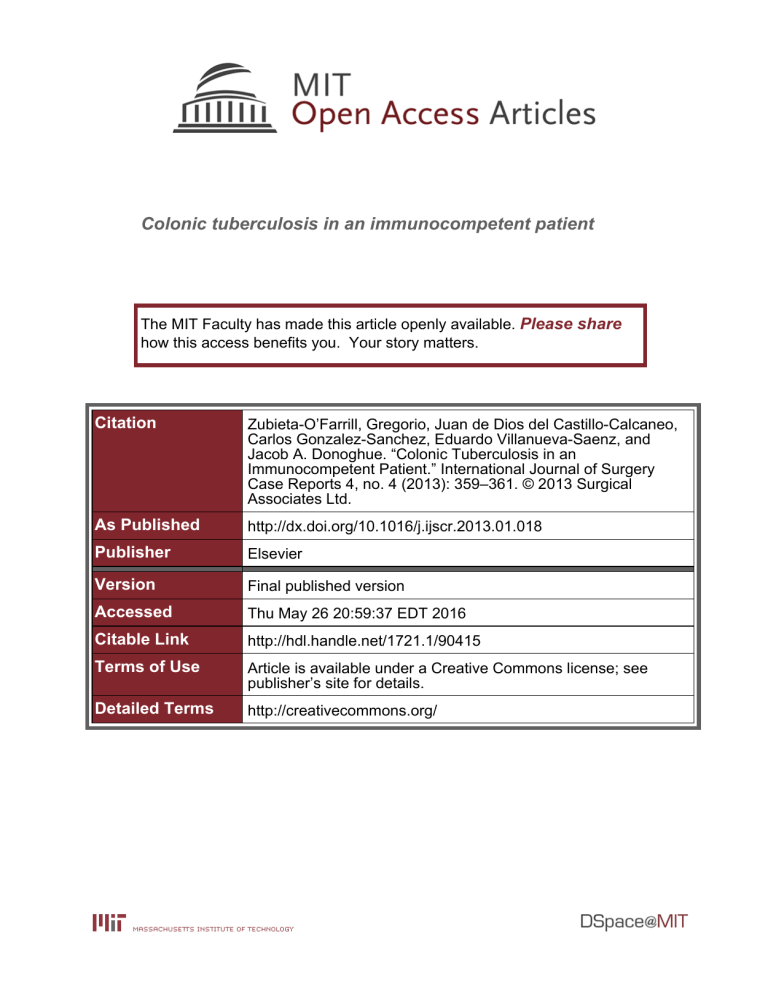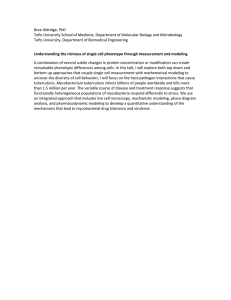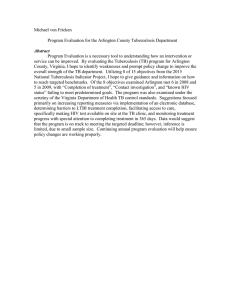
Colonic tuberculosis in an immunocompetent patient
The MIT Faculty has made this article openly available. Please share
how this access benefits you. Your story matters.
Citation
Zubieta-O’Farrill, Gregorio, Juan de Dios del Castillo-Calcaneo,
Carlos Gonzalez-Sanchez, Eduardo Villanueva-Saenz, and
Jacob A. Donoghue. “Colonic Tuberculosis in an
Immunocompetent Patient.” International Journal of Surgery
Case Reports 4, no. 4 (2013): 359–361. © 2013 Surgical
Associates Ltd.
As Published
http://dx.doi.org/10.1016/j.ijscr.2013.01.018
Publisher
Elsevier
Version
Final published version
Accessed
Thu May 26 20:59:37 EDT 2016
Citable Link
http://hdl.handle.net/1721.1/90415
Terms of Use
Article is available under a Creative Commons license; see
publisher’s site for details.
Detailed Terms
http://creativecommons.org/
CASE REPORT – OPEN ACCESS
International Journal of Surgery Case Reports 4 (2013) 359–361
Contents lists available at SciVerse ScienceDirect
International Journal of Surgery Case Reports
journal homepage: www.elsevier.com/locate/ijscr
Colonic tuberculosis in an immunocompetent patient
Gregorio Zubieta-O’Farrill a,∗ , Juan de Dios del Castillo-Calcáneo a ,
Carlos Gonzalez-Sanchez b , Eduardo Villanueva-Saenz a,c , Jacob A. Donoghue d
a
Surgery Department, Angeles Pedregal Hospital, México City, Mexico
Gastroenterology Department, Angeles Pedregal Hospital, México City, Mexico
c
Colon & Rectum Department, Angeles Pedregal Hospital, México City, Mexico
d
Division of Health Sciences and Technology, Harvard Medical School and Massachusetts Institute of Technology, Boston, United States
b
a r t i c l e
i n f o
Article history:
Received 9 December 2012
Received in revised form 10 January 2013
Accepted 22 January 2013
Available online 4 February 2013
Keywords:
Colonic tuberculosis
Tuberculosis
Colonoscopy in tuberculosis
Tuberculosis in immunocompetent subjects
a b s t r a c t
INTRODUCTION: One-third of the world’s population is infected with tuberculosis (TB), with intestinal
TB representing the sixth most common presentation of extrapulmonary TB. The diagnosis of intestinal
TB is a challenge for physicians due to its diverse clinical manifestations that mimic other infectious,
autoimmune, and neoplastic disorders, and is thus rarely considered as the causative agent of disease.
PRESENTATION OF CASE: We present a 55-year-old male with no relevant familial history, who presented
due to a loss of 10 kg of weight in 2 months accompanied by nocturnal diaphoresis and continuous
abdominal distension.
DISCUSSION: The incidence and the severity of intestinal TB are increased in immunosuppressed patients
and more rapidly progress due to deficient immune response. However, our immunocompetent had
severe progression resulting in surgery less than a month after the diagnosis was made.
CONCLUSION: While the diagnosis of intestinal TB, and specifically colonic TB, is difficult and is almost
never the first diagnosis entertained outside the immunocompromised population, we present a rare
case in which the disease presents in an immunocompetent patient.
© 2013 Surgical Associates Ltd. Published by Elsevier Ltd. All rights reserved.
1. Introduction
One-third of the world’s population is infected with tuberculosis (TB), with intestinal TB representing the sixth most common
presentation of extrapulmonary TB.1 The diagnosis of intestinal TB
is a challenge for physicians due to its diverse clinical manifestations that mimic other infectious, autoimmune, and neoplastic
disorders, and is thus rarely considered as the causative agent of
disease. Therefore, a high index of suspicion is essential to reach
the correct diagnosis.
2. Case report
We present a 55-year-old male with no relevant familial history, who presented due to a loss of 10 kg of weight in 2 months
accompanied by nocturnal diaphoresis and continuous abdominal
distension.
He was admitted to our hospital for studies. His complete blood
count (CBC) showed microcytic anemia and a fecal occult blood
test was performed and returned positive. These findings prompted
colonoscopy and gastroesophagoduodenoscopy, which revealed
∗ Corresponding author at: Angeles Pedregal Hospital, Camino a Santa Teresa
1055, Col. Heroes de Padierna, Magdalena Contreras, Mexico City, DF, Mexico.
Tel.: +52 1 55 3955 6584.
E-mail address: drzubieta@outlook.com (G. Zubieta-O’Farrill).
chronic gastritis and a colonic ulcer that extended throughout the
right colon (Fig. 1).
Biopsies were taken from the ulcerated area of the colon.
Histopathological analysis demonstrated an acute infectious process and a chronic infectious process with the presence of
granulomas (Figs. 2 and 3). The pathologic report suggested the
diagnostic possibility of tuberculosis and polymerase chain reaction of the same sample confirmed the presence of Mycobacterium
tuberculosis DNA.
HIV testing was confirmed negative. A positive PPD test
provoked an induration of 12 mm in the forearm at 12 h postinoculation and a chest X-ray was reported as normal. The subject
was discharged with Rifater (rifampin/isoniazid/pyrazinamide)
under strict supervision.
Two months after the patient was discharged, he presented to
the emergency department with abdominal pain in the left lower
quadrant, accompanied by tachycardia, bloody stools, rebound and
tenderness, and an abdominal CT was performed. Imaging discovered an abdominal mass obstructing the right colon at the ileocecal
valve (Fig. 4) and surgical intervention was immediately prepared.
A right hemicolectomy with ileotransversal anastomosis was
performed, with pathologic evaluation of the right colon demonstrating the colonic mass to be filled with granulomas and
characteristic multinucleated giant cells. The patient had a satisfactory evolution and was discharged.
At 1 year follow-up the patient is doing well and has finished
his course of Rifater treatment.
2210-2612/$ – see front matter © 2013 Surgical Associates Ltd. Published by Elsevier Ltd. All rights reserved.
http://dx.doi.org/10.1016/j.ijscr.2013.01.018
CASE REPORT – OPEN ACCESS
360
G. Zubieta-O’Farrill et al. / International Journal of Surgery Case Reports 4 (2013) 359–361
Fig. 4. Abdominal CT showing an obstructive mass in the right colon, at the ileocecal
valve.
3. Discussion
Fig. 1. Colonoscopy image showing an ulcer that extends throughout the right colon.
Fig. 2. Granuloma in colon biopsy with multinucleated giant cells.
Fig. 3. Granuloma in colon at the center of a lymphoid follicle.
The incidence and the severity of intestinal TB are increased
in immunosuppressed patients and more rapidly progress due to
deficient immune responses.1 However, our immunocompetent
patient had severe progression that resulted in surgery less than
a month after the diagnosis was made.
In case series reported previously, the main symptoms reported
in patients with intestinal TB are chronic abdominal pain, fever,
weight loss, changes in bowel habits, abdominal mass, ascites,
nausea, and vomiting.2 In our patient, only two of these major
symptoms were present, with weight loss being the main reason
for consultation.
Conventional laboratory tests are nonspecific and do not
contribute to the differential diagnosis. Elevated erythrocyte
sedimentation rate, high C-reactive protein levels, anemia, and
lymphopenia or lymphocytosis are common laboratory findings.3
In our patient, CBC showed anemia and oriented the physicians
toward a possible gastrointestinal bleeding. Positive fecal occult
blood test prompted the colonoscopy we performed, which led us
to the ultimate diagnosis.
Ulcers are the most common colonoscopy finding in patients
with diagnosed colonic TB, presenting in as many as 70% of these
patients.4 Our patient demonstrated these same characteristics in
his colonoscopy.
Granulomas are found in biopsies in up to 54% of all cases
reported by Alvares et al.,4 and are the most common histopathological lesion in colonic TB. These lesions were also reported for our
patient. Even though granulomas occur in both in tuberculosis and
Crohn’s disease, caseation characteristically typifies tuberculosis.
Caseation may be seen in the lymph nodes without concomitant
caseation in the colonic biopsy; additionally, it may be totally
absent in those who have received antitubercular therapy in the
past.5 In our case, caseation was not reported by the pathologist.
PCR is one of the confirmatory diagnostic tests used when there is
diagnostic doubt between TB and other diseases.4 Histopathologic
analysis suggested colonic TB as a diagnostic probability, leading
us to order the PCR test of the same specimen. The positive presence of Mycobacterium tuberculosis DNA conclusively confirmed our
diagnosis of colonic TB.
The Mantoux test is positive in 70–86% of patients, but has
limited usefulness in immunosuppressed patients.5 In our case, the
Mantoux test returned positive, which is expected in an immunocompetent individual.
A minority of patients with intestinal TB report prior history of
TB infection yet more than 50% have a normal chest X-ray.4 Our
CASE REPORT – OPEN ACCESS
G. Zubieta-O’Farrill et al. / International Journal of Surgery Case Reports 4 (2013) 359–361
patient had a normal chest X-ray and no previous history of TB,
which, as reported, is not uncommon.
361
is solely the responsibility of the authors and does not necessarily represent the official views of the National Institute of General
Medical Sciences or the National Institutes of Health.
4. Conclusion
Ethical approval
While the diagnosis of intestinal TB, and specifically colonic TB,
is difficult and is almost never the first diagnosis entertained outside the immunocompromised population, we present a rare case
in which the disease presents in an immunocompetent patient.
However, as rates of tuberculosis rise and as many as one-third of
the world’s population are already infected, intestinal TB should be
considered on the differential diagnosis of patients presenting with
similar sequelae of intestinal disease. Our case illustrates that, while
uncommon, intestinal TB can have a torpid course even requiring
emergency surgery despite adequate treatment.
Disclosure
The patient consent was obtained at the first hospitalization; our
local ethics committee reviewed the case prior to its submission for
publication.
Conflict of interest statement
No conflict of interest for any of the authors in this case report.
Funding
No funding was received specifically for this study.
Jacob Donoghue is supported by award Number T32GM007753
from the National Institute of General Medical Sciences. The content
Written informed consent was obtained from the patient for
publication of this case report and accompanying images. A copy
of the written consent is available for review by the Editor-in-Chief
of this journal on request.
Author contributions
Gregorio Zubieta-O’Farrill performed data collection and analysis. Juan de Dios del Castillo-Calcáneo did data collection and
writing. Carlos Gonzalez-Sanchez and Eduardo Villanueva-Saenz
did data collection while Jacob A. Donoghue did the writing
job.
References
1. Donoghue HD, Holton J. Intestinal tuberculosis. Current Opinion in Investigational
Drugs 2009;22:490–6.
2. Rasheed S, Zinicola R, Watson D, Bajwa A, McDonald PJ. Intra-abdominal and
gastrointestinal tuberculosis. Colorectal Disease 2007;9:773–83.
3. Muneef MA, Memish Z, Mahmoud SA, Sadoon SA, Bannatyne R, Khan Y.
Tuberculosis in the belly: a review of forty-six cases involving the gastrointestinal tract and peritoneum. Scandinavian Journal of Gastroenterology 2001;36:
528–32.
4. Alvares JF, Devarbhavi H, Makhija P, Rao S, Kottoor R. Clinical, colonoscopic,
and histological profile of colonic tuberculosis in a tertiary hospital. Endoscopy
2005;37:351–6.
5. Horvath KD, Whelan RL. Intestinal tuberculosis: return of an old disease. American
Journal of Gastroenterology 1998;93:692–6.
Open Access
This article is published Open Access at sciencedirect.com. It is distributed under the IJSCR Supplemental terms and conditions, which
permits unrestricted non commercial use, distribution, and reproduction in any medium, provided the original authors and source are
credited.





